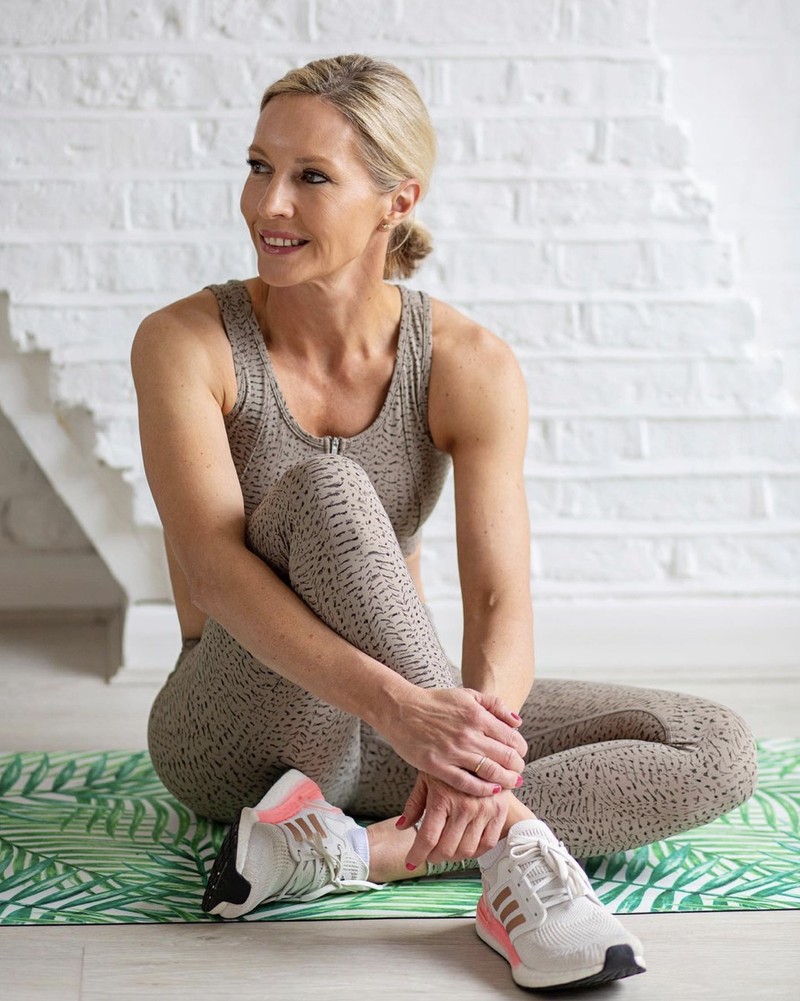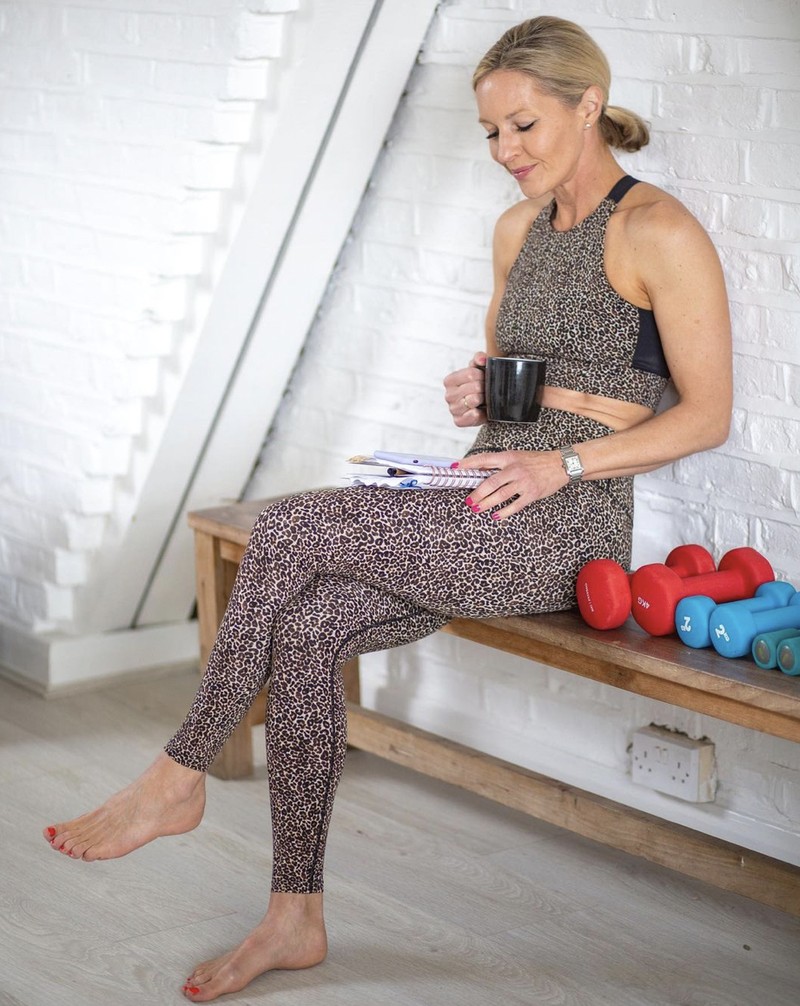
My Health Rules: Caroline Idiens
Fitness has always been part of my DNA. From a young age, I loved running, gymnastics and hockey, but never thought it could be a career. I began my career in advertising but always felt like there was something missing. In 2001, I made the decision to train as a personal trainer to pursue my love of exercise and the journey began there. Initially, I had a business in London training clients one-on-one, but we later moved to the countryside, so I began group exercise classes locally. At the start of lockdown, I took it all online via Zoom and was overwhelmed by the response. Since the start of the pandemic, Caroline’s Circuits has gone from strength to strength and I now feel I’m part of something so much bigger than before.
Strength training is vital as you age. My passion has always been strength training, and never more so than today. When I started my online classes, I quickly realised that for many women the missing link was strength – so many women fixate on cardio but miss the resistance training element, which is crucial as the body ages. Once we hit 30, our bone density and muscle mass decrease. Strength training plays a significant role in preventing this loss and we can actually build new bone by using weights. This can help reduce the risk of osteoporosis, which women are so susceptible to, especially post-menopause. Moreover, strength training gives you such a feeling of power in everyday life – it’ll help with sleep, anxiety, co-ordination and will also help you manage your weight.
Despite the misconceptions, it won’t make you bulky. At the age of 49, I’m stronger than I’ve ever been, and I also feel more confident with my body shape now than when I was younger. It’s a myth that using weights will make you bulky – unless you are using very heavy weights and dramatically changing your diet, this simply isn’t true. It’s also important to remember that you can’t spot reduce fat. Your body works as a whole and, whilst you can tone a particular area, working the full body consistently along with a sensible diet will make the difference.
In an ideal world, combine weights with cardio. While you may burn more calories in a cardio workout, strength training builds muscle. The two aren’t mutually exclusive and, for a leaner, fitter body, you should combine the two. Cardio is essential for heart health and for building stamina and endurance. At the same time, when we lift weights, we build muscle, boost metabolism and reduce our risk of injury.
My classes are all about variety. Circuits that involve interval training are a great way to alternate between several exercises to challenge different muscle groups, which is also important as you age. My workouts are designed for women 40+ and in the last year I’ve been overwhelmed by the response from women in this age bracket. They feel stronger and more confident. We fit a lot into each class – I include an element of HIIT (high intensity interval training) for those keen to raise the heart rate, but there are always low impact options, too. I haven’t repeated a workout in 18 months – variety really is the secret to results.
Mixing things up will keep the body challenged. The body adapts very quickly to the stimulus it is offered, and once your weights become too light you need to go heavier to keep seeing results. If you don’t, you’ll reach a plateau. Another common mistake I see women making when strength training is poor technique. If you want to start resistance training – whether with dumbbells or your own bodyweight – consider booking a PT session to get you going. This will also ensure you don’t get into any bad habits. Getting started is the hardest part, but exercise then becomes a routine and part of your lifestyle.
Resistance bands are a great alternative to dumbbells. I cannot recommend resistance bands highly enough – they’re a brilliant piece of kit which you can take anywhere. They’re especially useful to pack in a suitcase and are great for working out at home. Dumbbells are more versatile and are better for toning the upper body, but resistance bands are great for the legs. They work in a different way to a traditional pair of weights – with dumbbells, the weight is consistent through the full range of contraction; whereas, with a band, the resistance changes through the range of motion. Bands come in all shapes and sizes, and you can challenge yourself by upping your strength over time. The fabric ones are also incredibly tough.
Rest days are important. It’s on your rest days that the body recovers and rebuilds, so I always encourage clients to have one, if not two, days with just light exercise, whether that’s a walk or some stretching. If you don’t take a rest day, you’re more likely to get injured, which will mean you’ll be out of action for a long spell.
When it comes to diet, it’s all about moderation. Be mindful of snacking between meals and the foods you may eat which are just empty calories. Avoid anything that claims to be low-fat, as this tends to be packed full of sugar, sweeteners and nasties, and don’t use exercise as a way to be able to eat badly. When you are exercising, it’s important to fuel your body – remember you can’t run on empty.
I’ve always been a morning person. I’m a very early riser and am awake by 5:30 or 6am most days. I try to get seven or eight hours’ sleep every night, but this can be a challenge. Sleep is something we should prioritise – I find a lack of sleep really defines my mood for the following day as well as my food choices. My mornings start with a cup of tea and before I start teaching, I’ll have a banana and a coffee. Once the session is finished, I make a smoothie – usually avocado, spinach, banana, seeds, almond butter, protein powder and almond milk. I’m also a big fan of Marmite and eggs on toast.
Protein should feature at every meal. This is particularly important if you are exercising. My favourite way to eat protein is in the form of a big salad – go-to’s in our house include salmon fillets, chicken breasts and mozzarella with roasted vegetables. In the colder months, I love making a hearty soup at the weekend, which I then have on standby for the week ahead.
Finally, know that exercise benefits your mind just as much as your body. I cannot stress enough the power of exercise on mental health. The boost you get from exercising is like nothing else – the rush of endorphins will lift your day and I can quite literally feel the difference on the days I move my body. My mind is clearer, I can function with more clarity and I’m less stressed and anxious. Aside from exercise, setting time aside just for you is vital – whether it’s a walk outside, spending time on your skincare or reading in the bath.
Get 50% off your first month of Caroline’s Circuits classes by using SHEERLUXE50. Visit CarolinesCircuits.com for more information and follow Caroline on Instagram @CarolinesCircuits.
DISCLAIMER: Features published by SheerLuxe are not intended to treat, diagnose, cure or prevent any disease. Always seek the advice of your GP or another qualified healthcare provider for any questions you have regarding a medical condition, and before undertaking any diet, exercise or other health-related programme.
DISCLAIMER: We endeavour to always credit the correct original source of every image we use. If you think a credit may be incorrect, please contact us at info@sheerluxe.com.



